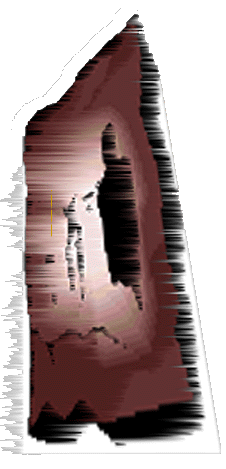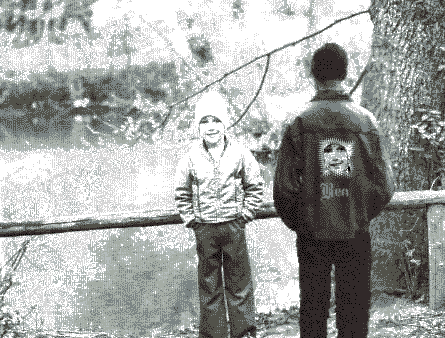
I have not dipped into the 'ayahuasca' cup
of the shamans and I remain somewhat in the dark about
why all of us are not seers. If it is inherent in
everyone, our systems must be effectively shutting us
down at some level. My own memories have suggested
nurture as a possible defense against the influences of
the culture. My mother covered the walls of the farmhouse
with mythmaking designs on which we were invited to
expand. I was over thirty before I realized she had,
consciously or unconsciously, done what mythologist
Joseph Campbell has described as 'cave-painting'. We
created a mythology of our own that celebrated nature and
a universal consciousness, rather than buying into that
of the culture. Every impulse was given outlet, every
fantasy looked upon as a chance to explore the reality
that existed within the self as well as outside with no
judgment attached. When children are continually drawn
out and encouraged to remember, to dream, to discuss
insight and depend on intuition as a matter of course,
the maze between conscious and sub-conscious levels of
knowing is easily retraced. The key to calling what we
know into consciousness is, first, re-call what we knew
as children. Then train the ability to recognize
ontological truth when we experience it and take risks in
using what we know, rather than making judgments.
Our culture lacks communal symbols for understanding
other ways of knowing so it overrides personal
experiences of truth. Language is no aid in this dilemma;
it is by nature, linear and precipitous. In the process
of allowing crystallization of awareness, language must
be used with great restraint until images are clear. If
we try to name things that are still unclear, we name
less than the truth. How will a culture, which co-opts
scientific language for use in the most inappropriate
contexts, (such as 'If you love me, prove it,') ever
accept multiple paths to perception? In my opinion, no
single discipline can validate experiences that deal with
synthesis rather than analysis. Adherence to a scientific
method that demands all existence conform to its measures
will reduce the universe to so much stardust. If evidence
points to a human capacity for seeing at the molecular
level, we can begin to let go of proofs and begin to
trust other ways of seeing in ourselves and each other.
If the brain apprehends knowledge at the molecular
level by means of hallucinogenic processes, what is to
prevent those accustomed to a lifelong awareness of inner
perceptions, from seeing reality in a spontaneous way?
Those who live with conditions such as ADD, autism and
dyslexia and other so-called anomalies, all possess
abilities of perception that set them apart. Others who
see 'differently' from the dominant culture are artists,
children and women, and all of us repress the altered
states we experience almost daily; dreams, imagination,
even empathy.
|
"Altered states of creative flow are brought on not by the drugs of shamans, but by energies tapped through meditative immersion in one's own resonant process."

We all know someone who is 'severely gifted' standing
on the edge of society for lack of recognition. Some had
insights of historical proportions; Copernicus, Columbus,
Da Vinci, Newton, Einstein. They passionately immersed
themselves in the elements of their questions; just as
children do, until the culture wraps them in its crudely
woven rationalism. The shamans did not hold the world at
arms length as an object to examine, but lived within it
and even took it into themselves, becoming one with it.
An example of this idea from the popular culture is how
the super logical Mr. Spok of Star Trek fame uses the
'Vulcan Mind Meld.' In spite of his devotion to logic,
the ultimate tool within his make-up is his ability to
unite himself with a given entity which otherwise defies
understanding.
In my own experience, a path for seeing exists in
creativity. It is a powerful tool for crystallizing
perceptions and seeing meaning. Altered states are brought
on, not by the drugs of shamans, but by energies tapped
through contemplative immersion in one's own creative
process. Being wholly present to process allows one to
become a 'neural ground' for awareness of the realities
underlying the symptoms of the human condition. Totally
flexible media allow the senses and the subconscious to
connect, inviting expression of the profoundly ineffable.
We can re-present what we see through the personal,
symbolic language of the arts. Giving attention to such
images in a communal way can provide us with meaning and
ontological truth. Retaining a holistic way of seeing is an uphill
battle. My sons, by virtue of gender, are at high risk of
isolation in this culture. I started noting their
thoughts early. When our oldest was four, he let me know,
"Dying is like losing a tooth, you just lose your
body". Seated quietly in our kitchen our middle son
was also four when he noted pragmatically one day,
"You always are who you're gonna be; you just don't
know it yet." Our youngest complained at about the
same age, "Adults tell us to pretend, because they
think what we're doing isn't real, but pretend is the
same as real in your brain." Today, in spite of a
system that teaches only what the culture needs them to
know, they are still able to access personal insight for
guidance. |
|
|
|  |
I have stopped
wondering what I will do next, in favor of looking for
relationships I will be part of. We have moved to the
country and live in the north, close to the earth. I've
founded a 'creativity think tank' leaving behind the
battle in favor of what I call 'dancing on the knowing
ground'. Like bees, others recognize actions, words,
images, shapes and sounds as symptoms of underlying
reality. The dance is universal; revelation happens.
Parker Palmer* writes, we can 'know as we are known'
at all levels of existence. Our purpose is to recognize
and develop the seer in all those who want to recover
their own way of knowing. Passionate involvement with
whatever we include in our lives provides something more
profound than truth; it gives us human ways of being that
coincide with the dance of the universe.
Jeremy Narby, "Cosmic
Serpent," Noetic Sciences Review, (April-July 1999),
pp.59-61
Parker Palmer, "To Know As We Are Known,"
(San Francisco: Harper San Francisco, 1983).
|
|

